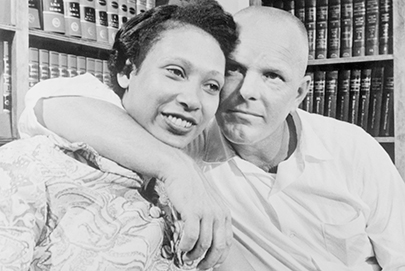At the end of the lesson, students will be able to:
- recognize how people’s experiences are shaped, in part, by their membership in groups defined by race, gender, socioeconomic status, culture, ethnicity and ability.
- recognize how people’s experiences are shaped, in part, by the historical moment and the society in which they live.
- understand the importance of the context in which a photograph was taken.
- What methods have been used to gain legal equality for African Americans?
- How does the U.S. Supreme Court’s decision in the case of Loving v. Virginia relate to other, more recent struggles for legal equality?
- Enduring Understandings
- A variety of methods have been used to gain legal equality for African Americans—including legislatures passing bills to guarantee rights and activists going to court to question the constitutionality of restrictive laws. For example, the Voting Rights Act of 1965 outlawed obstacles to voting (including poll taxes, literacy tests and grandfather clauses), and the U.S. Supreme Court decision in 1954 in the case Brown v. Board of Education helped put an end to legal segregation.
- Loving v. Virginia was a U.S. Supreme Court case that legalized interracial marriage, and its decision relates to current struggles of same-sex couples fighting for marriage equality under the law.
- Photograph of Mildred Jeter Loving and Richard Loving
- Excerpt from the Court’s ruling of the Loving case
- Computers (so students can visit the Web site of Marriage Equality USA)
- Student journals
Vocabulary
interracial [ in-ter-rey-shuhl ] (adjective) involving members of different races
invidious [ in-vid-ee-uhs ] (adjective) unfair, something that is likely to make people angry or unhappy
miscegenation [ mi-sej-uh-ney-shuhn ] (noun) marriage between an interracial couple
pursuant [ per-soo-uhnt ] (adjective) following
repudiate [ ri-pyoo-dee-yate ] (verb) to reject something
Suggested Procedure
1. Have students work in small groups of about three or four. Give each group a copy of the photograph (or display the photo on a whiteboard). Have students to look at the photograph, and ask, “What do you see? Describe the people in the photo. What do you notice about them? Do the people seem happy? What kind of relationship do you think exists between them? What makes you think so? What do you notice about the setting in which the photo was taken?”

Then ask, “Based on what you see, when do you think this photograph was taken? (You don’t need to guess the exact year; identifying the decade is close enough.) Why do you think so?” Have each group use the answers to the questions above to predict what makes this photograph significant.
2. Explain to the class the following: “The people in the photo are Mildred Jeter Loving and Richard Loving. The photograph was taken in 1967, after the Supreme Court ruled that their marriage was legal, overturning laws in Virginia and 15 other states that made it illegal for African Americans and white Americans to marry each other. The Court stated that the only reason that Virginia had outlawed the couple’s marriage was to ‘maintain White Supremacy,’—which violated the Equal Protection Clause of the 14th Amendment.” Next, have students review this handout featuring an excerpt from the Court’s ruling to learn more about the Loving case, and then answer the questions on the handout.
3. Ask students to think about the significance of Loving v. Virginia, and write a journal entry addressing these questions: “Had you heard of the case before? If so, what did you know about it? What, if anything, surprised you about the case? Do you know any couples that are interracial? Would this photograph be newsworthy in your community today? Why or why not?”
4. Tell students that another group in recent times was involved in a fight for the right to be legally married. Ask students, “What do you know about the movement to make it legal for same-sex couples to marry?” Tell students that they can read about it on the Web site of Marriage Equality USA. (Note: You can assign different students to read different parts of the site; or if you prefer, have them focus on these pages: Facts at a Glance and A Historical Look.) Have each student share something that he or she learned about the struggle for marriage equality.
Alignment to Common Core State Standards/ College and Career Readiness Anchor Standards CCSS: R.1, R.4, R.7, W.1, W.2, W.4, SL.1, SL.2, SL.4, L.4
